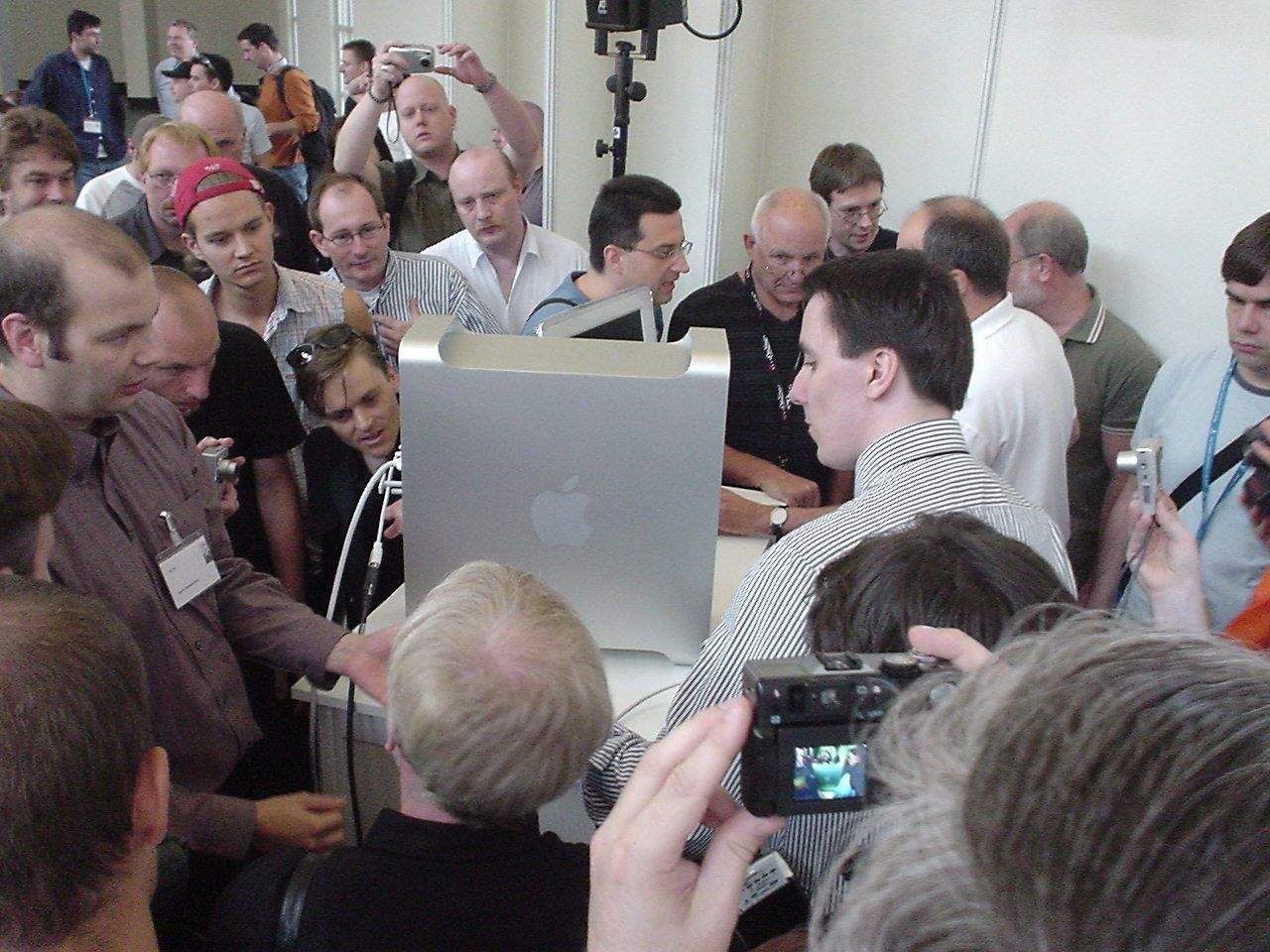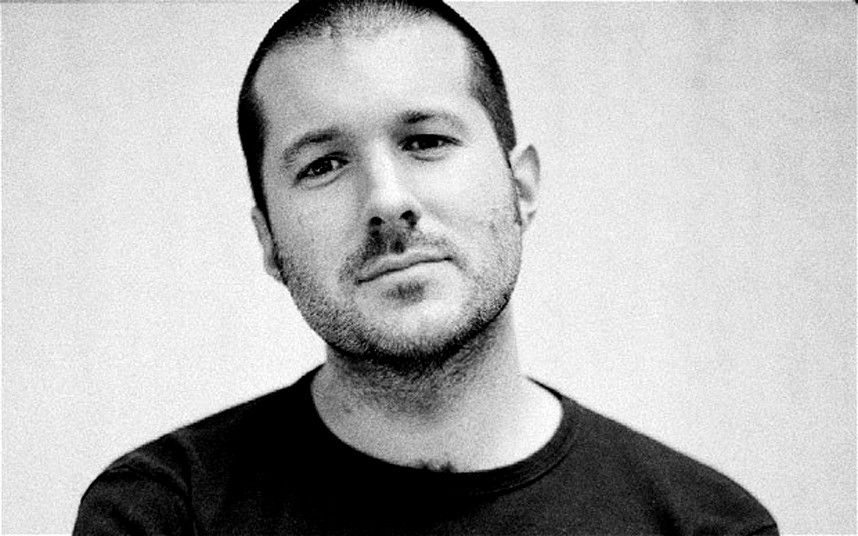The first time I met Jony Ive, he carried my backpack around all night.
Our paths crossed at an early-evening party at Macworld Expo in 2003. As a journeyman reporter hustling for Wired.com, I knew exactly who he was: Jonathan Paul Ive was on the cusp of becoming the world’s most famous designer.
I was surprised he was willing to chat with me.
We discovered a shared love of beer and a sense of culture shock, too, both of us being ex-pat Brits living in San Francisco. Together with Jony’s wife Heather, we reminisced about British pubs, the great newspapers and how much we missed British music (electronic house music in particular). After a few pints, though, I leapt up, realizing I was late for an appointment. I hurried off, leaving without my laptop bag.
This post contains affiliate links. Cult of Mac may earn a commission when you use our links to buy items.
Well after midnight I ran into Jony again, at a hotel bar across town. With great surprise, I saw he was carrying my backpack, slung over his shoulder.
That the world’s most celebrated designer carried a forgetful reporter’s bag around all night flabbergasted me. Today, though, I understand that such behavior is characteristic of Jony Ive. He focuses on his team, his collaborators, and, most of all, on Apple. For Jony, it’s all about the work—but when talking about his work, he replaces “I” with “we.”
A few months after our first encounter, I ran into him again at Apple’s Worldwide Developers Conference in June 2003. He stood to one side as Steve Jobs introduced the Power Mac G5, a powerful tower computer in a stunning aluminum case. Jony chatted with a couple of officious-looking women from Apple’s public relations department. After Jobs’s speech, I walked over to where Jony stood.
He beamed at me and said, “So nice to see you again.”
We shook hands and he asked in the nicest way, “How are you?”
I was too embarrassed to mention the backpack.
Eventually, I got around to asking, “Can I get a couple of quotes from you?” The PR reps standing by shook their heads in unison—Apple has always been famously secretive—but Jony replied, “Of course.”
He led me over to a display model on a nearby pedestal. I just wanted a sound bite, but he launched into a passionate, 20-minute soliloquy about his latest work. I could barely get a word in edgewise. He couldn’t help himself: design is his passion.
Made from a huge slab of aluminum, the Power Mac G5 looked like a stealth bomber in bare gray metal. The quasi-military aspect suited the times: those were the days of the megahertz wars, when Apple was pitted against Intel in a race for the fastest chips. Makers marketed computers on raw computing power, and Apple boasted their new machine was the most powerful of all. Yet Jony didn’t talk about power.
“This one was really hard,” he said. He began telling me how keeping things simple was the overall design philosophy for the machine. “We wanted to get rid of anything other than what was absolutely essential, but you don’t see that effort.
“We kept going back to the beginning again and again. Do we need that part? Can we get it to perform the function of the other four parts? It became an exercise to reduce and reduce, but it makes it easier to build and easier for people to work with.”

Reduce and simplify? This wasn’t typical tech industry happy talk. In releasing new products, companies tended to add more bells and whistles, not take them away, but here Jony was saying the opposite.
Not that simplifying was a new approach; it’s Design School 101. But it didn’t seem like Real World 2003. Only later did I realize that, on that June afternoon in San Francisco, Jony Ive handed me a gigantic clue to the secret of Apple’s innovation, to the underlying philosophy that would enable the company to achieve its breakthroughs and become one of the world’s dominant corporations.
Content to stand aside as Steve Jobs sold the public on their collaborations—including the iconic iMac, iPod, iPhone, and iPad—Ive’s way of thinking and designing has led to immense breakthroughs.
As senior vice president of industrial design at Apple, he has become an unequaled force in shaping our information-based society, redefining the ways in which we work, entertain ourselves and communicate with one another.
So how did an English art-school grad with dyslexia become the world’s leading technology innovator?
In the following exclusive excerpt from “Jony Ive: The Genius Behind Apple’s Greatest Products” you’ll meet a brilliant but unassuming man, obsessed with design, whose immense and influential insights have, no doubt, altered the pattern of your life.
Chapter 1
School Days
Its hydraulics were so well put together, that it folded out almost with a sigh. I could see the incipient talent that was coming out of Jonathan.
—Mike Tabberer

Wikimedia Commons image: https://en.wikipedia.org/wiki/File:Chingford_Mount_(Old_Church_Road)_Chingford_-_geograph.org.uk_-_2638823.jpg
According to legend, Chingford is the birthplace of sirloin steak. After a banquet at a local manor house late in the 17th-century, King Charles II took such delight in his meal that he is said to have knighted a large hunk of meat Sir Loin.
Another product of Chingford, Jonathan Paul Ive, entered the world much later, on February 27, 1967.
Like its latter-day son, Chingford is quiet and unassuming. A well-to-do bedroom community on the northeast edge of London, the borough borders the rural county of Essex, just south of Epping Forest. Chingford votes Conservative, as the constituency of Iain Duncan Smith, former leader of the Conservative Party, who holds a seat famously occupied by Sir Winston Churchill.
Jony Ive’s childhood circumstances were comfortable but modest. His father, Michael John Ive, was a silversmith, his mother, Pamela Mary Ive, a psychotherapist. They had a second child, daughter Alison, two years after their son’s birth.
Jony attended Chingford Foundation School, later to be the alma mater of David Beckham, the famous soccer star (Beckham attended eight years after Jony). While at school, Jony was diagnosed with the learning disability dyslexia (a condition he shared with a fellow left-brained colleague, Steve Jobs).
As a young boy, Jony exhibited a curiosity about the inner workings of things. He became fascinated by how objects were put together, carefully dismantling radios and cassette recorders, intrigued with how they were assembled, how the pieces fit. Though when he tried to put the equipment back together again, he didn’t always succeed.
“I remember always being interested in made objects,” he recalled in a 2003 interview conducted at London’s Design Museum. “As a kid, I remember taking apart whatever I could get my hands on. Later, this developed into more of an interest in how they were made, how they worked, their form and material.”
Mike Ive encouraged his son’s interest, constantly engaging the youngster in conversations about design. Although Jony didn’t always see the larger context implied by his playthings (“The fact they had been designed was not obvious or even interesting to me initially,” he told the London crowd in 2003), his father nurtured an engagement with design throughout Jony’s childhood.
Chip Off the Old Block

Mike Ive’s influence reached well beyond the precocious child in his own household. For many years, he worked as a silversmith and teacher in Essex. Described by one colleague as a “gentle giant,” he was well-liked and much admired for his workmanship.
His skill at making things led to his initial decision to teach handicraft as a career, but a later rise in the educational hierarchy afforded him wider influence. Mike was among the distinguished teachers plucked from daily teaching by the Education Ministry and given the grand title of Her Majesty’s Inspector. He assumed responsibility for monitoring the quality of teaching at schools nationwide, focusing specifically on design and technology.
At the time, British schools were trying to improve vocational education. A widening chasm lay between academic subjects and hands-on subjects like design, and the latter classes in woodwork, metalwork and cooking—in effect, shop-class subjects—were accorded low status and limited resources. Worse yet, with no accepted standards of teaching, as one former teacher put it, the schools “were able practically to teach what they wanted.”
Mike Ive took what came to be called design technology (DT) to a new level, establishing a place for the discipline as a part of the core curriculum in UK schools. In the forward-looking design and technology curriculum Mike helped devise, the emphasis shifted from shop skills to an integrated course that mixed academics with making things.
“He was way ahead of his time as an educator,” said Ralph Tabberer, a former colleague and schoolteacher, who would become the director general of schools in Prime Minister Tony Blair’s government in the new century. Mike helped write the mandatory curriculum that became the blueprint for all UK schools, as England and Wales became the first countries in the world to make design technology education available for all children between the ages of five and sixteen.
“Under his influence, DT went from being a marginal subject to something that occupied seven to ten percent of students’ time at school,” said Tabberer. Another of Mike Ive’s former colleagues, Malcolm Moss, characterized Mike’s contribution to the teaching of design technology: “Mike gained a reputation for being a compelling advocate for DT.” In practice, that meant Mike helped transform what was basically a goof-off class into a design tutorial and, in doing so, laid the groundwork for a generation of gifted British designers. His son would be among them.
Tabberer remembers Mike Ive talking about Jony’s progress in school and his growing passion for design. But Mike wasn’t a pushy stage dad, trying to turn his son into a prodigy like the father of tennis stars Venus and Serena Williams. “Mike’s influence on his son’s talent was purely nurturing,” said Tabberer. “He was constantly talking to Jonathan about design.
If they were walking down the street together, Mike might point out different types of street lamps in various locations and ask Jonathan why he thought they were different: how the light would fall and what weather conditions might affect the choice of their designs. They were constantly keeping up a conversation about the built environment and what made-objects were all around them . . . and how they could be made better.”
“Mike was a person who had a quiet strength about him and was relentlessly good at his job,” added Tabberer. “He was a very gentle character, very knowledgeable, very generous and courteous. He was a classic English gentleman.” These traits, of course, have also been ascribed to Jony.
The Move North

Before Jony turned 12, the family moved to Stafford, a medium-sized town several hundred miles north in England’s West Midlands. Sandwiched between the larger industrial city of Wolverhampton to the south and Stoke-on-Trent to the north, Stafford is a pretty place, its streetscapes lined with ancient buildings. On the edge of town the craggy ruins of Stafford Castle, originally established by the Norman conquerors of Britain in the eleventh century, stand guard over the city.
In the early 80s, Jony enrolled at Walton High School, a large, state-run school on the fringes of Stafford. Along with other local kids, he studied the usual grade-school subjects, and seemed to adapt easily to his new hometown. Fellow students remember a slightly chubby, dark-haired, modest teenager. He was popular, with a wide circle of friends, and took part in a number of extracurricular activities around the school. “He was a determined character—he settled in straight away,” said retired teacher John Haddon, who taught German at the school.
Although Walton had a computer lab stocked with early computers from the era (Acorns, BBC Micros and one of Clive Sinclair’s famous ZX Spectrums), Jony never felt at home there, perhaps because of his dyslexia. The computers of the era had to be programmed, keystroke by keystroke, on a blinking cursor command line.

Creative Commons-licensed photo by Mr Biz: https://www.geograph.org.uk/photo/209284
A local church organization, the Wildwood Christian Fellowship, a nondenominational evangelical congregation that met at a local community center, offered Jony a creative outlet along with other musicians he met at Wildwood. “He was drummer in a band called White Raven,” recalled Chris Kimberley, who attended Walton High School at the same time. “The other band members were much older than him. . . . They used to play mellow rock in church halls.”
Drawing and design offered another necessary relief from academic subjects as, early on, Jony showed abilities as a skilled draftsman and design technician. His relationship with his father continued to be a source of inspiration. “My father was a very good craftsman,” Jony remembered as an adult. “He made furniture, he made silverware and he had an incredible gift in terms of how you can make something yourself.”
At Christmas, Mike Ive would treat his son to a very personal present: unfettered access to his workshop. With no one else around, Jony could do anything he wanted with his father’s support. “His Christmas gift to me would be one day of his time in his college workshop, during the Christmas break when no one else was there, helping me make whatever I dreamed up.” The only condition was that Jony had to draw by hand what they planned to make. “I always understood the beauty of things made by hand,” Jony told Steve Jobs’s biographer, Walter Isaacson. “I came to realize that what was really important was the care that was put into it. What I really despise is when I sense some carelessness in a product.”
Mike Ive also took Jony on tours around London design studios and design schools. One formative moment occurred on a visit to a car design studio in London. “At that moment, I realized that making sculpture on an industrial scale would be an interesting thing to do with my life,” Jony later said. By the age of 13, Jony knew he wanted “to draw and make stuff,” but hadn’t quite pinned down exactly what he wanted to do. He contemplated designing everything—from cars to products, from furniture to jewelry and even boats.
Mike Ive’s influence on his son’s design development may not be quantifiable, but it’s irrefutable. He was a strong advocate of teaching empirically (making and testing) and of intuitive designing (“get on and make it, refine as you go”). In his slide presentations, the older Ive described the act of “drawing and sketching, talking and discussing” as critical in the creative process and advocated risk taking and a conscience acceptance of the notion that designers may not “know it all.” He encouraged design teachers to manage the learning process by telling “the design story.” He thought it essential for youngsters to develop tenacity “so there’s never an idle moment.” All of these elements would manifest themselves in his son’s process of developing the iMac and iPhone for Apple.
Jony drove himself to school each day, arriving at Walton behind the wheel of a tiny Fiat 500 that he called Mabel. In early 1980’s Britain, many post-punk and Goth teenagers wore black clothes, and Jony was no exception. His long black hair, teased into spikes several inches high, made him look like Robert Smith from the popular band The Cure—though without Smith’s heavy eyeliner. Jony’s hair spiked so high that it would have been flattened by the roof of his Fiat, so he opened the sunroof. Teachers remember the bright orange Fiat entering the school yard with a mop of spiky black hair poking out the top.
In those days—as now—cars were important to Jony. He and his dad were restoring another car, a vintage “frogeye” Austin-Healey Sprite with spherical headlamps that seemed to rise out its hood like a couple of wide-open eyes. While the look was unusual, giving the small, two-seater sports car an approachable, anthropomorphic appearance, the design was intriguing, too, as the Sprite had a semi-monocoque body, meaning the car’s external skin was structural.

At school, Jony’s skills as a designer were beginning to emerge. A school friend and fellow design student, Jeremy Dunn, remembered a clever clock that Jony produced. Matte black, with black hands and no numbers, the design allowed the timepiece to be mounted in any orientation. Though made of wood, the clock’s black finish was so flawless his friends couldn’t tell what it was made from.
With the possibility of university studies looming, Jony began to prepare for A-levels, the standardized qualification tests for university admission in the United Kingdom. His primary emphasis would be design technology, then a two-year combined course. In the first year, students explored the character and capabilities of different materials, ranging from wood and metal to plastics and fabrics, almost any material. The idea was to give students the opportunity to develop ideas and learn practical skills before the second year, which was more academic, and centered on a major project.
“It was very hands on,” recalled Craig Mounsey, a designer who took the course at the same time as Jony. “We were being taught execution skills and at the same time design process skills.”
Jony’s work was exceptional and his drawing excellent. His teachers recalled that they had not seen his standard in another student of his age before; even at age seventeen, his designs were often production ready. “His graphics were brilliant,” said Dave Whiting, a faculty member who taught Jony design and technology for several years. “He used to draw initial designs on brown craft paper with white and black pens, which was a really effective and new way to do that. He had a different way of presenting ideas. His ideas were novel, innovative, fresh.”
“Jony was so good,” Whiting added, “we learned a lot from him, through looking at his work.”
Not only was Jony skilled at the crafts side, he was exceptionally good at communicating his ideas. “He did things that other people weren’t doing,” said Whiting. “When you are a designer, you have to be able to convey your ideas to people who are not designers; perhaps they are financing you or going to do the production, and you have to be able to turn them on to the product and its feasibility. Jony was able to do that.”
His teachers recognized how sophisticated his work was, and some of Jony’s drawings and paintings were hung in the head teacher’s office. “They depicted parts of churches, arches and details of tumbling-down churches and ruins, which were very accurate pencil sketches, as well as watercolors,” said Whiting. When the head teacher’s office was redecorated some time during the late 1980s, the sketches disappeared, but people remembered his skills. “I have heard Jony say that he is not good at drawing,” Whiting said in an interview, “but that’s not true.
“Jony saw, even in the early days, the importance of line and detail in products. For instance, he designed some mobile phones that were slim and detailed, like modern phones, even while he was still a school student.” Jony’s interest in phones was not just adolescent tinkering. He would continue to design new phones through his later schooling (and, of course, at Apple).
For his second-year project, Jony chose to design an overhead projector (OHP). DT students were required to produce initial ideas, refine them, make presentation drawings and mock-up models, and, if possible, build the actual product. The task was more than a theoretical exercise on paper: It was a complete design process, concept to completion.
The project also required market research. Jony knew that OHPs were standard issue at schools and businesses at the time. They sat on teachers’ desks, projecting images of transparent slides onto walls and whiteboards. The ubiquitous machines were all big and bulky, but Jony, having researched the OHP market, decided there was an opening for a portable model.
He designed a light OHP that would collapse into a matte black briefcase with lime green fittings. Highly portable, it was very modern looking—and quite unlike the clunky, utilitarian desktop OHPs of the day. When the lid of the case was opened, it revealed a Fresnel lens with a magnifying glass and a light underneath. As with traditional OHPs, transparent film images placed on the screen were then projected via a series of mirrors and a magnifying lens onto the wall.
Ralph Tabberer, a teacher friend of Mike Ive’s, recalled being impressed when he saw the portable OHP for the first time. “Its hydraulics were so well put together, that it folded out almost with a sigh. I could see the incipient talent that was coming out of Jonathan.”
The teachers at Walton liked Jony’s project and decided to enter it, along with those of a few other students, into a national competition. That year, the Young Engineer of the Year Award, sponsored by the British Design Council, was to be judged by the internationally famous architect and interior designer Terence Conran. For the first round, the entrants submitted graphics, drawings and photographs. The most interesting designs were then chosen for the next stage of the competition.
Jony’s portable OHP project was among those selected for round two. Before sending his OHP for the next stage of judging, Jony took it apart for a final clean and polish. When he put it back together, however, he inadvertently inserted the lens backward. As a result, instead of projecting a clear image, the inverted Fresnel lens sprayed light in all directions, rendering the image indistinguishable. As submitted, the device was useless, and the judges rejected Jony’s design. Still, his idea was certainly unique: Though he didn’t win, a not-dissimilar portable OHP hit the market not long afterward.
A Rare Sponsorship
At 16, Jony’s talent was already beginning to gain the attention of the design world.
Philip J. Gray, the managing director of London’s leading design firm, Roberts Weaver Group, spotted Jony’s work at a teacher’s conference.
As Her Majesty’s chief inspector for design, Mike Ive organized what became an annual conference to promote design in the national curriculum. When Phil Gray arrived to be the event’s keynote speaker, he laid eyes on Jony’s work for the first time.
In the conference foyer a small exhibition of design work by high school students had been installed. Among the work on display were some pieces by Jony. Gray was drawn immediately to Jony’s sketches of toothbrushes. Much later, Gray recalled the “fine lines in pencil and crayon,” and “the quality of thinking and analysis” evident in the work of the young design student.
“His work stood out as being very mature for a 16- or 17-year-old,” Gray said. “I remarked what an extraordinary talent. Mike replied, ‘that’s nice because that was done by my son Jony.’”
A few days later, father and son visited Gray at the Roberts Weaver Group offices in central London. Over lunch, Gray gave the Ives some advice about the best colleges for ID. “I made a few recommendations,” Gray recalled. His top recommendation was Newcastle Polytechnic.
During lunch, Mike Ive also asked a cheeky question: Would Gray’s company sponsor Jony though college? In return for an annual stipend (about £1,500 for each of four years), Jony would promise to work for the design firm after graduation. Sponsoring was very unusual at the time, but Gray agreed.
“Jony is the only person I sponsored at RWG,” Gray said. “We had interns, who came to work with us during summer breaks from university—but Jony was the only student we sponsored…I had no problem persuading the other directors at RWG to sponsor Jony, because he had shown some clear talent.”
Although it might appear that Mike Ive was driving his son to pursue a career in design, Gray didn’t believe that was the case. He thought Mike was just responding to his son’s growing obsession with design. “Mike used his position to be able to rub shoulders with the design elite and he hoped that some of that would rub off on Jony,” Gray allowed, adding that Jony “was a very smart engineer . . . Father and son were both very enthusiastic. A liking for design was just in the family.”
In the years that followed, Gray had more opportunities to observe father and son. “They were so alike; shy but very focused and [they] always got things done without fuss,” he said. “I never recall raised voices! My memories are mostly of smiles and the pleasure of being with them rather than raucous laughter. Mike’s pride was there to see but never spoken about. It’s unusual but talent and modesty can go together.”
His father’s influence was evident in Jony’s temperament as well as in their shared love of design. “Mike Ive was a real enthusiast who always loved what he did,” said Gray. “He was a really energetic person and desperately keen for his son to succeed. He was simply a caring father who tried to make sure that Jony had all the best opportunities to get on as a designer.”
In his years at Walton High School, Jony opted to study not only design technology at an advanced level but also chemistry and physics, which was unusual for an arts-oriented student. When he graduated from Walton High School in 1985, he did so with an A in each of his three A-level exams. The hard work of two years of preparation paid off, as earning three top grades wasn’t easy: According to UK government statistics, his results put him in the top 12 percent of students nationwide.
These grades made him eligible to apply for Oxford or Cambridge, the best known of the UK universities. Having been interested in studying to be a car designer, he also considered Central Saint Martins College of Arts and Design in London, one of the world’s leading art and design schools. But when he visited, the place didn’t seem to be a good fit. Jony found the other students “too weird,” as he put it. “They were making ‘vroom, vroom’ noises as they did their drawings.”
With his academic record and evident talents, Jony had choices. In the end, he did as Phil Gray had advised and opted for Newcastle Polytechnic in the North of England. Product design was to be his main thing.
Leander’s new book about Jony Ive and the Apple design studio is was published November 14. Jony Ive: The Genius Behind Apple’s Greatest Products is available from Amazon and other good booksellers.




